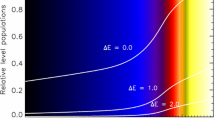Abstract
The angular diameters, radii, and effective temperatures of 16 G0–G5 main-sequence stars with color excesses 0.60≤B-V≤0.68 and parallaxes derived from Hipparcos data have been determined using their infrared fluxes, obtained from JHKLM photometric observations. For all the stars except BS 483, these effective temperatures differ from the spectroscopic temperatures by no more than 1–2%. Such differences are within the uncertainties expected for the IR-flux method. The effective temperatures of BS 483 derived from its infrared fluxes are 3% higher than those indicated by spectroscopic observations; this may be due to the specific atmospheric structure of this star. Spectroscopic observations at 3400–7500 Å and JHKLM photometric observations are compared with analogous solar data and Kurucz models. The best agreement with the model with T eff=5750 K and logg=4.5 in the interval 4400–7500 Å was obtained for BS 7503 and BS 7504 (16 Cyg A and 16 Cyg B). The infrared color indices H-K, K-L, and K-M for these stars differ from the corresponding solar indices, and their angular diameters grow with wavelength, which is not the case for the Sun. H-K for BS 6060, currently considered to be the closest analog to the Sun, is near the solar value. The vast majority of the stars studied (13 of 16) have higher luminosities than the Sun. These include 16 Cyg A, 16 Cyg B, and 51 Peg, which thus cannot be considered full “twins” of the Sun.
Similar content being viewed by others
References
G. Cayrel de Strobel, Astron. Astrophys. Rev. 7, 243 (1996).
G. Cayrel de Strobel, Hipparcos and Tycho Catalogues ESA SP-1200 (1997).
I. B. Voloshina, I. N. Glushneva, V. T. Doroshenko, et al., Spectrophotometry of Bright Stars, Ed. by I. N. Glushneva (Nauka, Moscow, 1982).
I. N. Glushneva, E. A. Makarova, and A. V. Kharitonov, Highlights Astron. 7, 853 (1986).
V. G. Kornilov, I. M. Volkov, A. I. Zakharov, et al., Tr. Gos. Astron. In-ta im. P.K. Shternberga 63 (1991).
I. N. Glushneva, Astron. Zh. 71, 652 (1994).
I. N. Glushneva, G. V. Borisov, V. I. Shenavrin, et al., Astron. Astrophys. Trans. 18, 633.
Solar Analogs: Characteristics and Optimum Candidates, Ed. by J. Hall (Lowell Observatory, 1998), p. 182.
G. Cayrel de Strobel and E. D. Friel, Solar Analogs: Characteristics and Optimum Candidates, Ed. by J. Hall (Lowell Observatory, 1998), p. 93.
A. É. Radzhip, V. I. Shenavrin, and V. G. Tikhonov, Tr. Gos. Astron. In-ta im P.K. Shternberga 58, 119 (1986).
H. L. Johnson, R. I. Mitchell, B. Iriarte, et al., Comm. Lunar Planet Lab. 63, 99 (1996).
J. Koornneef, Astron. Astrophys., Suppl. Ser. 51, 489 (1983).
D. E. Blackwell and M. J. Shallis, Mon. Not. R. Astron. Soc. 180, 177 (1977).
R. L. Kurucz, CD ROM 13 (1993).
I. N. Glushneva, Astron. Zh. 60, 560 (1983).
E. A. Makarova, A. V. Kharitonov, T. V. Kazachevskaya, et al., Balt. Astron. 7, 467 (1998).
I. N. Glushneva, A. V. Kharitonov, L. N. Knyazeva, and V. I. Shenavrin, Astron. Astrophys., Suppl. Ser. 92, 1 (1992).
D. S. Hayes, Calibration of Fundamental Stellar Quantities, Ed. by D. S. Hayes, L. E. Pasinetti, and A. G. Philip (Reidel, Dordrecht, 1985), p. 225.
M. S. Bessel and J. M. Brett, Publ. Astron. Soc. Pac. 100, 1134 (1988).
A. V. Kharitonov and L. N. Knyazeva, Izv. VUZ (Radiofizika) 39(10), 1234 (1996).
L. Colina, R. C. Bohlin, and F. Castelli, Astron. J. 112, 307 (1996).
D. Labs and H. Neckel, Zeits. Astrophys. 69, 1 (1968).
E. A. Makarova, A. V. Kharitonov, and T. V. Kazachevskaya, Solar Radiation Flux (Nauka, Moscow, 1991).
W. Wamsteker, Astron. Astrophys. 97, 329 (1981).
Author information
Authors and Affiliations
Additional information
__________
Translated from Astronomicheski\(\overset{\lower0.5em\hbox{$\smash{\scriptscriptstyle\smile}$}}{l} \) Zhurnal, Vol. 77, No. 4, 2000, pp. 285–294.
Original Russian Text Copyright © 2000 by Glushneva, Shenavrin, Roshchina.
Rights and permissions
About this article
Cite this article
Glushneva, I.N., Shenavrin, V.I. & Roshchina, I.A. Solar analogs: Spectral energy distributions and physical parameters of their atmospheres. Astron. Rep. 44, 246–254 (2000). https://doi.org/10.1134/1.163847
Received:
Issue Date:
DOI: https://doi.org/10.1134/1.163847



